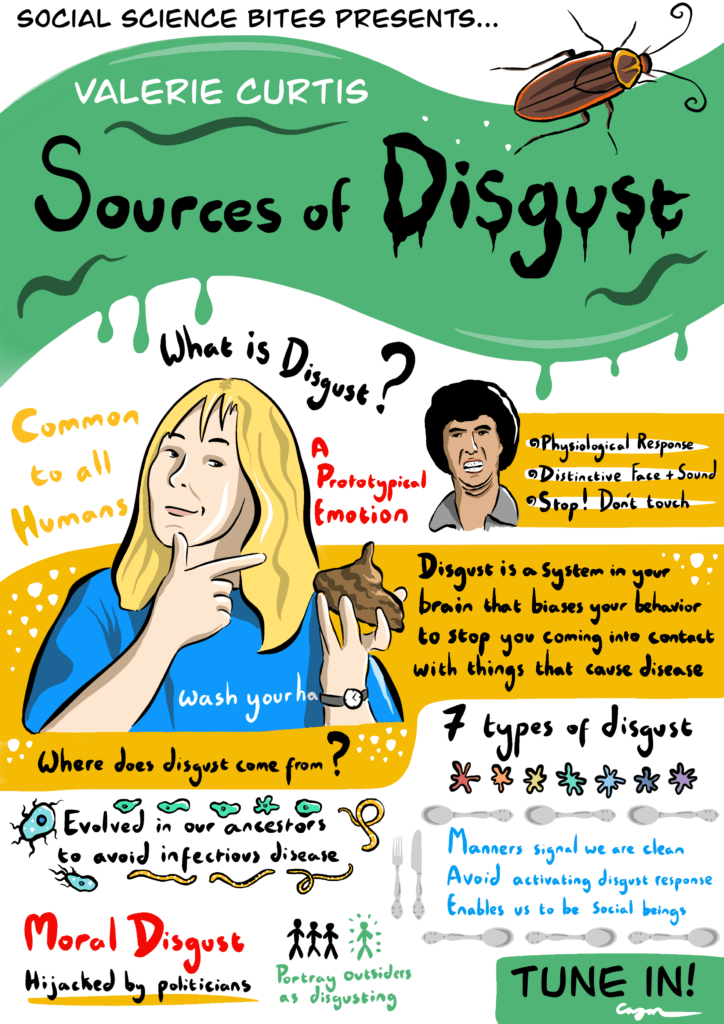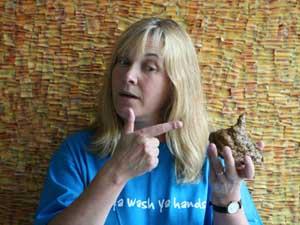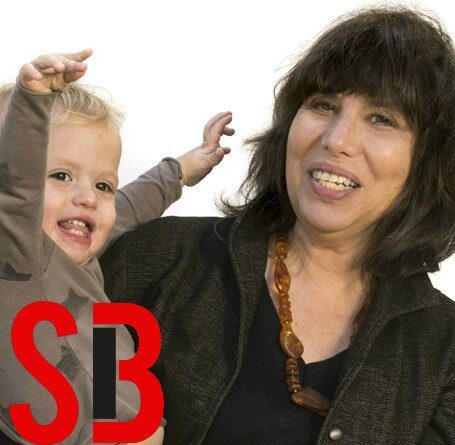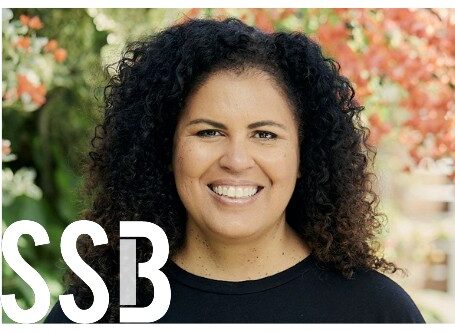
This illustration is part of a series of Social Science Bites illustrations by scientific illustrator Alex Cagan. We’ve looked through our archives and chosen some of our favorite episodes from over the years, which Alex has brought to life in these visualizations. We’ll be unveiling new illustrations in this series through June and July 2020 on our Twitter page. Catch each new illustration as it’s released at the hashtag #SSBillustrated and click here to view all the illustrations so far.
Think of cockroaches, other people’s bodily fluids, a man sitting close to you on the bus whose face is covered in pustules, a toilet brush used to wash dishes. Yuck! At the London School of Hygiene and Tropical Medicine, Val Curtis has become a taxonomist of different — she says there are seven – types of disgust, and she explains them in this episode of the Social Science Bites podcast. Click HERE to download a PDF transcript of this conversation. The full text also appears below. To directly download this podcast, right click HERE and “Save Link As.” Social Science Bites is made in association with SAGE. For a complete listing of past Social Science Bites podcasts, click here.
***
David Edmonds: Think of cockroaches, other people’s bodily fluids, a man sitting close to you on the bus whose face is covered in pustules, a toilet brush used to wash dishes. Yuck! At the London School of Hygiene and Tropical Medicine, Val Curtis has become a taxonomist of different -‐ she says there are seven -‐ types of disgust.Nigel Warburton: What sort of things are we talking about? Valerie Curtis: The lists included maggots, flies, food that had gone off, people who were behaving in unhygienic ways -‐ for example throwing dirty hankies on the floor, or not flushing the toilet after them -‐ but it extended also to people who were behaving in immoral ways. So we found in India, for example, people thought that kissing in public was disgusting. We did a sample in Athens International Airport, and the most disgusting thing people said was American politicians, it was the time of George Bush, for example, that they thought was disgusting, so a very, very broad range of disgusting things. Nigel Warburton: We’ve been talking about disgust, but it’s not absolutely clear what it is. Is it a physiological response? Valerie Curtis: If I show you something disgusting in a jar, and you pull the lid off and have a sniff at it, you’re going to feel a particular way. Your gut is going to churn probably, you’re going to pull a distinctive face, which is like a ‘Eugh’, you pull up your top lip, you’re very likely to make this ‘Eugh’ sound, which is pretty much common throughout the globe. But more important than all of those things, you’re actually going to stop and go ‘I don’t want to touch that thing, I don’t want to look at it, I don’t want to touch it, I certainly don’t want to eat it’, and it’s that behavioral reaction, ultimately, that defines disgust, for me. Disgust is a system in your brain that biases your behavior to stop you coming into contact with things that might make you sick. Nigel Warburton: I can understand that in terms of physical things, but in terms of ideas, people’s disgusting ideas, or of disgusting politicians, isn’t that just a metaphor? Valerie Curtis: That’s a very good question. There’s a lot of things that connect those two. Studies have shown that if I tell you about somebody’s disgusting behavior, and somebody’s morally disgusting behavior, you’ll pull the same face, you will report having similar feelings, and some of the same parts of your brain will light up; and there have been some social science experiments as well, that show that, if for example, you think about having done something immoral, you are likely to want to wash your hands more, for example. On the other hand, there’ve been some problems with some of those studies, and we’ve not been able to replicate them: so we’re not sure whether they’re secure enough or not. I think the evidence is still out on whether moral disgust and visceral disgust, or organic disgust, are still the same thing. On the other hand, you know, if it looks like a bear, sounds like a bear, runs like a bear and behaves like a bear, then maybe we should say, ‘yes it is a bear.’ That’s where I stand at the moment on that one. Nigel Warburton: And you think there’s a common source of all these different forms of disgust? Valerie Curtis: If you line up all the things that people find disgusting -‐ and let’s put moral disgust on one side for the moment -‐ every single one of the things people find disgusting, you can trace an infectious disease origin to them. So that’s why I call this the Parasite Avoidance Theory of Disgust. I’ve lived a very large part of my life in Africa and in Asia, and in those countries, more than 50 percent of all deaths are due to infections. There’s a very high selection pressure from infectious disease, and that must have been true throughout all of our history. There’s far more danger from microbes on the planet, than there are from predators, for example, but people are perfectly happy with the idea that, for example, if the ancient world that we lived in was full of lions therefore we have evolved a sense of fear in our brains to keep us away from these big animals that are likely to eat us up from outside. Well, disgust is strictly parallel, except that it’s a sort of fear of little animals that want to eat us up from inside. Nigel Warburton: So this is an evolutionary story of why we would end up with a feeling of disgust and revulsion when we see things which might be prone to give us some kind of disease or parasite? Valerie Curtis: Yes. I mean if you think about it, if you had an ancient ancestor, let’s say your great great great great great great great great great great great -‐ right back to the Pleistocene -‐ who actually liked putting their fingers in poo, and going ‘Mmm, delicious aha’, was that ancestor going to find a mate easily, was that ancestor going to have a lot of offspring and was that ancestor going to bring them up successfully? No, their kids would have been sick and died, they probably wouldn’t have had very many children in the first place. So that person wouldn’t have been your ancestor, so in fact your ancestor was probably quite squeamish, and was actually quite good at avoiding things like poo and open wounds and insects that might cause disease. So all of us are the descendants of people who had a good, strong sense of disgust. Nigel Warburton: Are humans the only animals that can feel disgust? Valerie Curtis: It’s really controversial as to whether animals have emotions or not, and I think that really depends on how you define emotions. If you defined the emotion of disgust as being a system that drives you to avoid parasites and pathogens that might make you sick, then of course the same applies to animals, and C. elegans a one millimeter long nematode worm alive today, put it in a Petri dish, put it with a pathogenic organism, and what does it do, it worms its way away from the pathogen. In other words, it’s doing disgust, it’s doing disgust-‐driven behavior. Does it have the emotion of disgust? That is controversial, but I would say that all animals have to avoid the pathogens and parasites that would otherwise eat them up, and they would be extinct, if they didn’t have a disgust system. Nigel Warburton: Given that the longest period of human evolution probably occurred in the Pleistocene, isn’t it odd that there’s such diversity in different cultures about the things we find disgusting? Valerie Curtis: I would say that disgust is universal to all animals, all animals including human beings. The general themes of all of the things we find disgusting, everywhere on the planet are the same. In fact, there are seven different types of disgust which you find in every culture in the world. Anthropologists have usually harped on about the differences that there are. Mary Douglas, for example, starts with her theories about disgust from the differences that you find between cultures. I don’t. I start from the universality of disgust, and its universal task that it has to play. We all, everywhere on the planet, share these basic themes of the things that we all find disgusting. There are no cultures where poo, for example, is something that people like. There are no cultures where sharing bodily fluids, except for a few, few people who you make an exception to, is something that is acceptable or good manners in any culture in the world. But there are differences. Disgust is a system which teaches you what to learn, so it teaches you that a rat is probably something disgusting, but if you were in a culture like in the Netherlands, for example, where a rat is a sweet little pet, and every time you meet a rat, nobody pulls a disgust face, everyone goes ‘Aw, how sweet’, then perhaps disgust doesn’t apply to a rat in certain cultures. The same for meats: there are different sorts of meats that are taboo in different cultures. The human animal actually taboos every sort of meat, we don’t eat, the vast majority of meat, we don’t eat; we only have a little window that allows us to eat the things that our mothers fed to us, because meats are highly suspect: they’re likely to be absolutely full of microbes. In ancient societies with no refrigeration, you want to be extremely careful about what meats you eat. Nigel Warburton: That’s really interesting. What you seem to be saying is that the emotional response to things in the world that we have somehow, innately, is a framework which allows us then to learn the specifics of cultural taboos? Valerie Curtis: Put very well. That’s exactly how I believe the emotions work. We come equipped with a system which tells us to focus on certain things, and not on other things, and we pay attention to the things that are biologically salient. So I may see thousands of people walk past me, but the one that jumps out at me is the attractive man who might be a potential mate. I may see 24 plates of food go past me in a restaurant, but the one that smells bad, or looks funny is going to be the one that jumps out at me, and if I taste it and it tastes bad, then I’m going to learn very early, not to eat that sort of food again, and particularly not to go back to that restaurant again. Nigel Warburton: This sounds as if it’s a level where we’re not really consciously thinking about it, we just have a disgust reaction, and yet obviously we’re capable of reflecting on the feelings that we have, and disgust is more complex, surely, than just a visceral response? Valerie Curtis: Well, first of all I don’t think that feelings are definitive of emotions. An emotion is a system that makes you behave in a certain way. So love makes you behave in a way that makes you sacrifice for the sake of a pair bond, for example. Why do we have feelings then? Well, most of what we do every day we can do perfectly well without our prefrontal cortex, without this uniquely primate part of the brain where our conscious brain resides. The clever trick evolution played that make us different from animals is to have this theater in our mind, is to have this ability to imagine the future. We’re able to take memories of things and project them into the future, that way we can weigh up future options against now. I can say to myself, being slim and beautiful in the future is such an attractive option that I’m prepared to forego my lunch now because I can imagine it. Now, no other animals can do that: they can’t hold alternative futures in their heads and weigh them up against each other. That’s what feelings are for, you look up your feelings, you have conscious experience of feelings, so that you can use them as tokens to map your chessboard of the future, and choose the one which will bring you the greatest value in the future, so that is the evolutionary trick that humans have played that allow us to be this extraordinary prescient animal, who is able to imagine, for example, working together to build a space station. No other animal can do this collaborative, collective work that produces this extraordinary world we live in today. Nigel Warburton: In your research, you discovered seven basic types of disgust, so what are the implications of this, what does that show us? Valerie Curtis: First of all, I think intellectually it’s extremely interesting because I think of disgust as a prototypical emotion, and I think that we should be able to do the same with all of our emotions, we should be able to pull apart sub-domains to associate it with a particular task, that love, or status, or affiliation, or hoarding, we think there are about 13 main human motives stroke emotions that we can pull apart in this way, so that’s really interesting. Secondly, we use disgust in our work. Most of my work is actually in developing countries, trying to promote the avoidance of disease. Diarrhoeal diseases and respiratory infections kill more children than malaria, or HIV, or TB all put together, but they’re much neglected, partly because they’re disgusting conditions, I think. So part of what I’m trying to do is to shout to the world about how important it is that we deal with these issues. Some of our programs, we’ve actually tried to elicit disgust, to get people to wash their hands, for example. So we had a very successful campaign in Ghana where a TV ad showed mums coming out of the toilet, and there was a sort of stain painted onto their hands, and then they cook their foo-foo, and then they feed the foo-foo to the child, and you see the child about to eat a foo-foo that’s got these finger marks on it, and every mother who saw that ad went ‘Ugh!’, and it was shocking and horrifying, and it increased hand-‐washing from about 12 to about 40 percent in Ghana nationally. So understanding exactly what elicits what type of disgust, if you’re going to use it in public health, is really very important. Nigel Warburton: I can see the immense value in understanding hygiene through disgust in terms of protecting people from infectious diseases, which is the source from an evolutionary point of view, of the whole framework of disgust, but when you come to moral disgust, many people would think that the yuck reaction is one that we should reflect on, and possibly overcome, because it’s so often used as a way of attacking people who are different from us. Valerie Curtis: Yes, I think that disgust is very much a double-‐edged sword. If it’s true, as I’m hypothesizing, that there was a progression from disgust into manners, which is about me, I want to get the benefit of social life with you, but you’re a bag of pathogens, so I don’t want to come too close to you. So I have to learn a lot of good manners, rules that keep my bodily fluids away from you, otherwise you will be disgusted by me, and not want to interact with me, and also I have to learn courtesy and rules that help me interact with you so that we can get all the benefits of social life, I think that flowed out of disgust, and I think that is actually proto-morality, so I think there is a really interesting story to be told about how, in fact, the need to avoid pathogens was one of the first social tricks we had to learn in becoming the hyper-social beings that we are today. It’s a big problem for society to solve. Some of our work on moral disgust shows also that we’re deeply disgusted by lots of immoral behavior, but particularly immoral behavior that involves things like bodily fluids. So rape, or wounding, wounding a horse, for example, are all things that people find extra morally disgusting, but also the idea that if you’re behaving like a social parasite, a social pathogen, I’m going to be disgusted by you -‐ many reasons for us to think that morality and disgust are linked. Now, let’s say you’re a politician, you want to get votes, so what do you do? You say that the outsiders are disgusting, and that makes everybody want to join up together and vote for you, against the outsiders. Every time there are elections come round, you do get this pattern of talking about immigration, for example. Now, it works, because we do have this innate tendency to see outsiders as disgusting; but we need to know about that, and we need to ridicule the politicians that are using that trick. But we mustn’t forget that we are disgusted by all sorts of moral infractions and when I’m disgusted by you stealing from an old lady, that makes me want to shun you, and if I shun you, that’ll make you ashamed, which means you’re less likely to do it. So I think I have a duty to be disgusted by you, when you behave immorally, because I’m helping support the fabric of society to make us all behave more morally. So disgust, when we use it all the time against the little infractions, the little discourtesies, the people who jump on the train without saying sorry, who stick their elbow in you, you’re disgusted by that behavior, you’re disgusted by the politician who behaves hypocritically, you’re disgusted by the rapist -‐ it’s important to express that disgust, because that is what helps, keeps society moral after all. Nigel Warburton: I’m really intrigued by the number of different disciplines that you pull together here, because you’re an epidemiologist, you’re a scientist, you’re an anthropologist, you’re working broadly within the framework of the social sciences, but drawing very heavily on medical science, evolutionary theory as well. Do you see yourself as a social scientist? Is that your self-definition? Valerie Curtis: I like to think of myself as being post-‐disciplinary. I came to this field because I wanted to change human behavior to improve health, but I came to a field where I couldn’t find good theories, good approaches that would help me learn about human behavior well enough to change it. So we’ve had to go back to the source, which is evolution. If you look at behavior in an evolutionary perspective, you start to understand why we behave the way we do, and ultimately, if we’re going to understand why we behave the way we do, then we’re going to get much better at changing it. So I think that you have to take a spanner from here, and a piece of wire from here, and a little bit of string from there, and whatever it is that works, to solve your problem, that’s what you should use. Nigel Warburton: Valerie Curtis, thank you very much Valerie Curtis: Pleasure, thank you.Your ancestor was probably quite squeamish, and was actually quite good at avoiding things like poo and open wounds and insects that might cause disease. So all of us are the descendants of people who had a good, strong sense of disgust.
Social Science Bites
Welcome to the blog for the Social Science Bites podcast: a series of interviews with leading social scientists. Each episode explores an aspect of our social world. You can access all audio and the transcripts from each interview here. Don’t forget to follow us on Twitter @socialscibites.
View all posts by Social Science Bites
































































































“It’s really controversial as to whether animals have emotions or not, and I think that really depends on how you define emotions. If you defined the emotion of disgust as being a system that drives you to avoid parasites and pathogens that might make you sick, then of course the same applies to animals, and C. elegans a one millimeter long nematode worm alive today, put it in a Petri dish, put it with a pathogenic organism, and what does it do, it worms its way away from the pathogen. In other words, it’s doing disgust, it’s doing disgust-‐driven behavior.”… Read more »